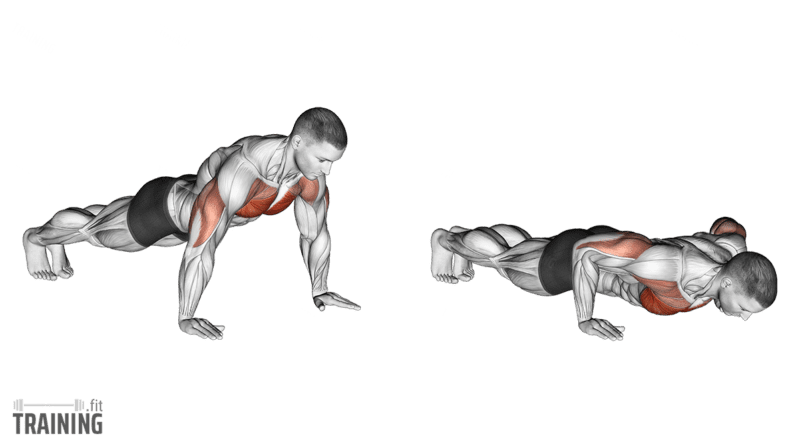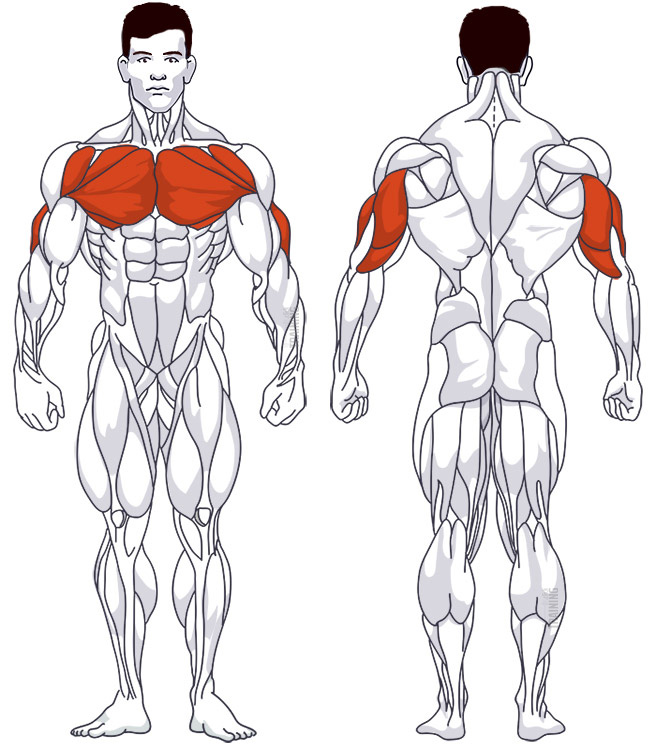Push-Ups
Compound exercise, Body weightThis article is verified by 2 studies/publications.
Overview

Main muscles
- Chest: Large pectoral muscle
(Musculus pectoralis major) - Shoulder: Anterior deltoid muscle
(Musculus deltoideus, Pars clavicularis) - Triceps: Three-headed arm muscle
(Musculus triceps brachii)
Push-Ups: Basics and alternatives

Involved main muscle groups:
Push-Ups
Push-ups are one of the most well-known fitness exercises ever. Everyone knows them, and almost everyone has done them at least once in gym class. The basic movement goes like this: With your arms extended and your body straight, you support yourself on your hands and toes. By bending and extending your arms, you primarily move your upper body.
Push-ups aim to train the chest muscles and triceps with this movement sequence. Since several muscle groups are trained, push-ups are considered a compound exercise.
Since you can perform the exercise anywhere without any equipment, it’s also perfect for training at home. Push-ups are an excellent alternative to barbell bench presses.
Other variations of push-ups include decline push-ups or push-ups with a gymnastics ball.
Correct execution
Even though everyone knows push-ups, the correct execution isn’t as trivial as you might think. There are several ways to perform the exercise with different muscle or training focuses. The muscle focus is varied by the width of the support, and there are also different placement options for the arms and legs in terms of height.
So what’s the best, most effective way to perform push-ups?
Best hand distance
The support width determines the intensity of muscle activation. It’s often claimed that wide push-ups would activate the chest better. However, this isn’t true, as a study from 2016 shows [1].
In fact, the activation of the triceps and chest is lower in wide push-ups than in shoulder-width or narrow grips push-ups. The wide grip, on the other hand, is better for activating the front rectus muscle, as was also found in the same study.
Narrow push-ups in a diamond grip have proven to be the best variant for activating the chest and triceps. In this grip, your fingertips are directed at an angle of about 45 degrees to each other. The disadvantage is that this grip is occasionally considered uncomfortable.
Best arm and leg position
Typically, push-ups are performed with hands and toes on the floor as support. However, the exercise can also be varied. You can support your arms on an elevated position so that the upper body remains higher in the bent position than the legs. Or, you can support your legs on a higher position so that they are always higher than the upper body when the arms are extended (decline push-ups).
A study from 2011 found that an elevated leg position (not surprisingly) requires more effort[2]. This is because the center of gravity is shifted further toward the upper body, and you have to move more body weight during the movement.
This means push-ups with legs positioned higher (e.g., on a flat bench) also increase muscle activation in the chest and triceps. This is an efficient way for advanced people to perform push-ups.
On the other hand, beginners can support their hands higher and reduce the difficulty. Also, angling the knees, which is often referred to as “girl push-ups”, makes it easier to start.
Video tutorial
Step-by-step instructions
Kneel on the floor and lean your upper body forward far enough, so you can support yourself with your hands (shoulder width).
Extend both legs and balance on your toes.
Extend both arms and move your hands so they’re roughly below your shoulders. If you like, you can vary the width of your support in this step (see above).
Tense your core so that your head, upper body, and legs form a nearly straight line. Don’t stick your butt out too far and don’t let your pelvis sag. You’re now in the starting position.
Slowly and controlled, lower your upper body down by bending your arms. End the movement when your chest is just above the floor. If you’re using a higher support position for your arms or legs, end the movement when your elbows are fully bent.
Hold the position for a brief moment and then straighten your arms (almost) all the way. Keep your body tensed throughout the entire movement in the manner described earlier.
Push-Ups with Additional Weight
Regular training often allows you to quickly increase the number of push-ups you can do. This raises the question of whether you can also use additional weight to make the exercise a bit more challenging and provide enough motivation to keep your muscles growing.
Here are several options:
- You can place a weight plate on your back between your shoulder blades, but there’s always the risk that the plate will shift and distract from a clean execution.
- If you’re training at home, you can strap on a backpack filled with water bottles to provide additional weight. Backpacks with chest and belly straps work best, as they are less likely to shift.
- Our recommended option for additional weight is a resistance band that runs behind your back and is held with your hands. With different resistance bands, you can easily vary the intensity over a longer period of time.
Common mistakes
The body posture during push-ups is crucial for good muscle stimulation. Often, you see people either sticking their butt out too far or letting their hips sag. Both are negative for the effectiveness of the exercise. To perform push-ups correctly, make sure your body is straight, and your core stays tense. Your head, upper body, and legs should form a line.
Incomplete execution is also often unconsciously done. If the arms are not fully bent and the upper body is not fully lowered, it naturally reduces the training effect. Therefore, pay attention to a complete exercise execution as much as possible.
Both can be best controlled by performing the exercise in front of a mirror at first or simply filming your training and analyzing it afterward.
Another important point is the training speed. To do a lot of push-ups, you often see the movement executed quickly. This usually results in an incomplete execution, with either the arms not fully extended or the upper body not fully lowered. Therefore, pay attention to a clean, controlled execution. What’s important is a good muscle feeling, not just the number of repetitions.
Sources
- Effect of the push-up exercise at different palmar width on muscle activities. Kim, Y.-S., Kim, D.-Y., & Ha, M.-S. (2016). Journal of Physical Therapy Science, 28(2), 446–449. doi:10.1589/jpts.28.446. URL: https://www.ncbi.nlm.nih.gov/pmc/articles/PMC4792988/, accessed on 18.11.2020
- Kinetic Analysis of Several Variations of Push-Ups. Ebben, W. P., Wurm, B., VanderZanden, T. L., Spadavecchia, M. L., Durocher, J. J., Bickham, C. T., & Petushek, E. J. (2011). Journal of Strength and Conditioning Research, 25(10), 2891–2894. doi:10.1519/jsc.0b013e31820c8587. URL: https://pubmed.ncbi.nlm.nih.gov/21873902/, retrieved on 11/18/2020